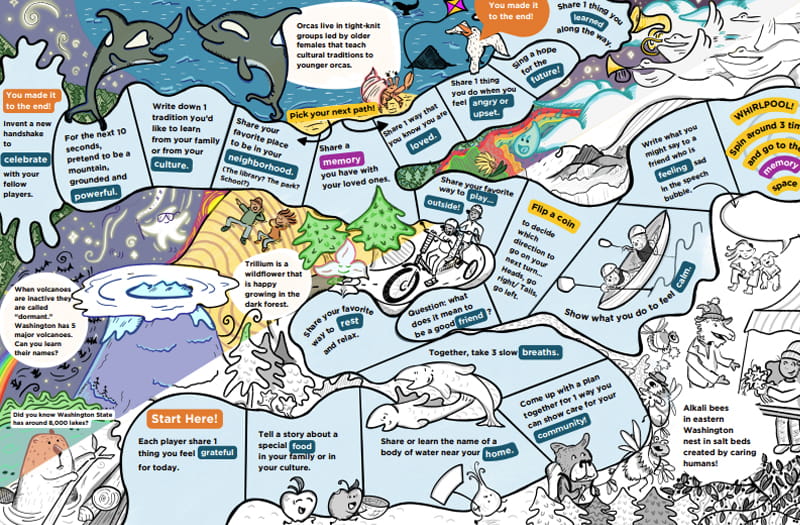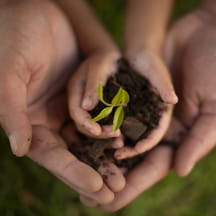Surrounded by illustrated volcanoes, Alkali bees, and orcas are 21 squares for children, families, and friends to learn about each other.
The first prompt is read aloud: “Share one thing you feel grateful for today.”
The youngest kid starts: “Mac and cheese.”
“A good night’s sleep,” Mom says.
The 13-year-old jumps in: “That you still hug me even when I act too cool.”
Seattle Children’s didn’t create just any board game. They created an activity to foster deeper connections, spark meaningful conversations, and build resilience.
The River of Connection game is based on the Healthy Outcomes from Positive Experiences (HOPE) Framework and uses play to promote positive childhood experiences (PCEs) that drive healthy child development and help kids thrive.
“The game is an entrée into conversations to help families increase access to positive childhood experiences,” said Beth Crispin, program manager of community health family connections and medical-legal partnerships. “We want to increase awareness of how PCEs impact child development, mental health, and long-term health.”

Built with hope
Each space along the illustrated river guides families through the four building blocks of HOPE: relationships, environment, engagement, and emotional growth.
But kids and adults don’t recognize that they’re moving through a framework.
They’re simply spending intentional time with each other discussing what it means to be a good friend, sharing stories about a special food in their family, coming up with a plan to show care for their community, and taking three slow breaths together.
The game was conceived by Crispin and Faith Eakin, program manager and senior community mental health worker, who are both certified HOPE facilitators.
“Part of my inspiration was the need to create positive, engaging experiences for kids and families to have outside of technology and be present and get to know each other on deeper levels,” Eakin said. “That is really what it has become. Parents are learning new facts and seeing their child in new ways, and it feels fun and enjoyable.”
The game is part of Seattle Children’s efforts to support child and family well-being and resilience by fostering and nurturing parent-child relationships and increasing access to PCEs.
Early childhood offers the greatest opportunity for preventing and mitigating harm and setting the path for healthy development.
At the center of the HOPE framework are PCEs that can buffer against negative lifelong effects of adverse experiences and lead to resilience and reduce health risk behaviors and chronic diseases.
“A lot of people might be feeling burnout or the weight of the world,” Crispin said. “This reminds us of simple ways we can lift up and celebrate the things in life.”
And as each player lands on a square, they are surfacing HOPE and creating positive experiences together.
Created by wonder
It took six months to develop a game that was both playful and impactful.
Crispin and Eakin worked with Bryan Wilson, Seattle educator and artist who uses wonder and imagination as a tool for growth.
“It was critical to find the right partner,” Eakin said. “He brings expertise in creating activities and games already, so he could blend those two things really well.”
Diverse parent-child reviewers offered feedback to ensure the game’s accessibility and relevance.
One family recommended the use of household objects to play the game so no play pieces or dice are required, making a printer the only thing needed. Players can move through the squares with a coin, paper clip, or small stone.
A little girl took her feedback a step further.
She sent an email to Crispin and Eakin, suggesting a diagonal down the center of the game, with one half full of color and the other half waiting to be colored in by the players.
“It was such a genius idea directly from a kid,” Eakin said. “You can see that it is just a thoughtful, engaging, great piece of art. And it meets kids and families where they are, so they want to pick it up and look at it.”
Filled with connection
The game, which is available in English and Spanish, has been played by child life specialists, social workers, and early childhood-focused community organizations. It can also be found in hospital newsletters, the patient education website, and at workshops that train people on the HOPE framework.
And there are plans to promote it on digital screens throughout the hospital and have the game available in waiting rooms.
Seattle Children’s community mental health worker team and three school-based clinics have also been sharing the resource.
An elementary school handed out the game to spark connection, insight, and growth for families.
At first, adults can feel a little uncomfortable answering vulnerable questions with their children. But after a couple minutes, the tension breaks and conversations are filled with stories, giggles, and surprises.
One mom wasn’t sure how it was going to go when her kindergartener landed on the space that reads “Sing a hope for the future.”
But her son made up a tune on the spot, and it turned into a sweet moment they wouldn’t have had otherwise.
Another mother was grateful for an activity without screens.
“Life can be quite busy, and it can be difficult to find meaningful time to connect with your kids over important topics,” she said. “This gives us intentional time to do that while also having fun.”
Crispin and Eakin are also working on a toolkit to help other hospitals develop similar resources that encourage play and reflect the cultural and community context of the families they serve.
Celebrating positives
The flip of a coin begins more than a game. It starts a simple way to flow through meaningful conversations that celebrate moments that matter.
And by the end of the game, everyone is a winner.
“We often focus on what’s wrong, and this focuses on what’s strong,” Crispin said. “That positive exists everywhere, in every child and every family. Play-based activities give an entryway into celebrating the positive that all of us have.”


